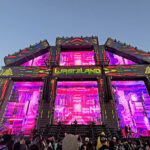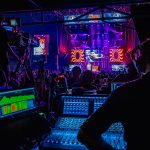The late summer heat didn’t prevent festivalgoers from traveling in packs and arriving in droves to attend Electric Zoo: Transformed, an electronic music festival held on Randall’s Island, New York City, September 4 through 6. The crowd arrived dressed in animal masks, superhero garb, or “barely there” outfits we’re sure are illegal in at least three states. Clearly, the zookeeper had left the building, the cage doors were open, and young people of all stripes shed their inhibitions and, presumably, their everyday clothes for a walk on the wild side.
But we don’t want to give you the wrong impression. The weekend was far from out of control — and that’s the way festival organizers preferred it. Drug-related deaths in 2013 and a massive storm, bringing a premature close to the 2014 event, has cast a long shadow across the Electric Zoo festival. It’s a perception that presenters SFX Entertainment/ID&T hoped to change through tight security and, most conspicuously, a name change to Electric Zoo: Transformed.
Transformed?
Although Billboard magazine reported that ticket sales dropped 30 percent from 2013 to 2014, Electric Zoo wasn’t exactly on the most endangered festival list prior to the revamp. PLSN spoke with a few performers on the bill in advance of the event to document their expectations. Most were confident of the 2015 E-Zoo’s success.
“The weather forecast says it’s going to be amazing weather, so this is already a big plus, you know?” Veteran Belgian DJ Marco Bailey told PLSN. “I expect a lot: Good vibes, good music and the sun shining everywhere. Over the last two or three years people are more and more interested to go to the festival and less and less the clubs. For them, going to the festival is almost like taking the family on vacation.”
Rebranding
Electric Zoo hosted acts on five stages in Randall’s Island Park (i.e. Main Stage, Hilltop Arena, Riverside, Sunday School Grove andTreehouse), not far from Icahn Stadium. Appearances by artists working in a range of electronic subgenres, included Chemical Brothers, Borgore (with special guests G-Eazy performing “Forbes”), Alesso, Above & Beyond, Gramatik, Audien, Zeds Dead, Madeon, Adventure Club, The Glitch Mob, Pete Tong, Galantis (Christian Karlsson and Linus Eklöw), Deorro, Five Knives, Peking Duk, 3LAU, Sam Feldt andMarco Bailey, among many others.
Producer ID&T and parent company SFX hired Detroit-based Burst Sound & Lighting Systems LLC to rig the lighting and video, providing the trussing, motors, towers for the rigging system. They supplied all the actual lighting gear (some 3,000 fixtures in all were spec’d) and other aspects of the behind-the-scenes work.
It was Burst’s mission, in part, to help ensure that Electric Zoo presented a cogent and coherent message, one that would help to rebrand the festival. “SFX came directly to us,” Burst owner Scott Ciungan says. “I think the promoters and producers wanted new blood and were trying to transform the experience of the entire festival.”
Burst arrived on Randall’s Island with 28 trucks of gear and made quick work of the job. Over 10,000 feet of Tyler GT truss needed to be rigged. Some pre-rig was done, but the company’s techs began work onsite just three days prior to the event to hang motors. “There were over 200 rigging points, which is crazy,” Ciungan says. “The goal was to get everything on the GT truss, pre-rigged, pre-cabled. The Glitch Mob also brought a full lighting system. Above & Beyond requested an additional floor package. Chemical Brothers brought a huge floor lighting system we had to interface with, not to mention the two robots, with variable speed motors that need to be triggered from the grandMA console.”
Synchronicity
Just as Electric Zoo was rebooting, Burst was undergoing its own sort of metamorphosis. Since Ciungan bought Burst in 2012, his focus has been diversifying the company’s business. Once only a regional firm largely dealing in audio and catering to the underground electronic dance music world, Burst has, in recent years, opened up new markets. Audio continues to play a big part in Burst’s ballooning revenues, but lighting is now just as important to the company’s bottom line.
As of this writing, Burst had provided audio and/or lighting for numerous music cruises and festivals across North America, including the recent Cheap Trick/Peter Frampton tour, Electric Forest in Michigan andPemberton Music Festival in British Columbia, one of Canada’s largest music festivals. “I started pursuing national tours and festivals, expanding our roster,” says Ciungan.
The Electric Zoo gig has emerged as a turning point in Burst’s move toward lighting. Because the Main Stage’s design called for a quick, bright, versatile, small and affordable lighting unit, Burst knew it needed a very specific fixture to get the job done. The Ayrton MagicBlade seemed to be the most logical choice. This solution proved problematic, however. Due to high demand, the Blades were difficult to secure with such short notice.
All was not lost, however. When it was discovered that Elation’s brand-new seven-light ACL 360 Bar had features similar to the MagicBlade, including a continuous rotation function, Burst was intrigued. “Burst bought the first batch of Elation Bars that were available,” says John Dunn, rental and production market manager at Elation. “They needed a specific amount, and typically, it was the size of one of our entire shipments.
“Moon [Steven “Moon” Fitzgerald, former vice president of sales, national, at Burst] was a big supporter of Elation products in his previous jobs,” continues Dunn. “He believed the Elation fixtures could bring the quality needed and stepped up to the plate and brought the idea to Scott. Given the price point, Burst could buy into the fixtures and not have to sub-rent.”
“The ACL 360 Bar was an amazing choice for this festival,” says Fitzgerald. “It was a decision in which I could not turn down. When you’re looking at fixtures for events, it’s always a challenge. I love challenges. When I found out about the fixture, I quickly called [director of sales] Eric Loader at Elation Lighting, Inc., and we talked in length about them.”
We couldn’t have written it any better. Call it synchronicity: a cutting-edge lighting unit gobbled up by a revitalized company for use at a festival that was, itself, being shepherded into a new chapter of its existence. “The unit, I feel, outperforms other fixtures in its class,” Fitzgerald says. “The brightness, changing of colors smoothly and the speed of the pan were out of this world. I would use these time after time.”
“For Burst, it was a bigger step into lighting for them,” says Dunn. “Burst is holding those as their inventory, and the fixtures will be a resource for sub-rentals across the country.”
This Bird Was Flown
We noticed it right away — and from afar. While crossing over the RFK Bridge on foot, a good distance from Randall’s Island Park, we were struck by the Main Stage’s trussing and scaffold grid design arranged in the image of a phoenix.
Constructed by Brown United and Tait Towers, the Phoenix was composed of 14 truss pieces, fanned out at different angles, forming the great bird’s wings. The main body was composed of five trusses. In addition, an intricate array of trussing, positioned at various angles, formed the brow, face and head. (Two High End Systems Showgun fixtures created the impression of eyes.)
Each eight- and ten-foot stick of truss carried a assortment of lighting fixtures including Elation ACLs. Trim topped out at a height of over 70 feet. To complete the production of the Main Stage, the boys at Burst flew 2,000 feet of GT truss off the grid. Screenworks provided the X7HD 7mm video wall, measuring 340 meters across. Video was secured to the scaff structure, arranged in a cutaway pattern to add dimension to the Phoenix wings.
Riverside
We couldn’t believe our eyes. We thought that SFX had really released the kraken! Well, actually, to be more accurate, Riverside (the second-largest outdoor stage), was designed to resemble another, similar sea monster — a giant octopus with its tentacles scrolling out over the length of the stage. A scaffolding system was constructed to support the inflatable creature and80 meters of Screenworks X-12N LTE 12mm LED video screen were used for the head and the front section of the DJ area.
In darkness, the giant mollusk’s big bulging eyes seemed to glow, but no lighting fixtures were placed inside them we were informed. (Eight Elation Platinum beams formed a semicircle, a kind of halo, enveloping the octopus’ head. A second truss ring formed part of the beast’s head and eyes, securing Fresnels.)
Hilltop Arena
As was the case for nearly all of the stages, Hilltop Arena, the largest indoor stage, boasted a scaff and truss grid system, securing 72 Clay Paky Sharpys, 39 MAC Vipers, 30 Martin Atomics and 18 Spectral M800 Tour. Two large center trusses ran nearly the length of the tent; two shorter parallel truss lengths appeared on either side of these large tracks. Overall, the design spoke to simplicity, symmetry andversatility. The Sharpys were tapped to create a light beam grid or cage, in keeping with the zoo concept.
Some of the most provocative video imagery was shown at Hilltop. Netherlands-based Eyesupply designed video content. (Onsite video was operated via Resolume Arena.) “We created a brand-new portable server with two GeForce GTX 980 Ti cards in it so we could easily handle the five HD outputs we needed to supply for the screens,” says creative director and founder Carlo Ruijgers.
Galantis, one of the acts that performed at Hilltop, featured an alluring animation of what can only be described as a strange hybrid animal. “It was a coincidence that the animal content we created for Electric Zoo really fit with the performance of Galantis,” says Ruijgers. “This is a kind of happy accident that you hope for during a festival show. We created a small amount of content on site, but most was created in our studio.”
Going to Church
The Sunday School Grove site was basically one giant, six-post circus tent, with minimal amount of trussing. Scaffolding helped secure various video panels and lighting fixtures and two tracks of trussing, hung on either side of the tent, elevating 2 Lite Molefays and Sharpys, for blasts and beam effects.
Screenworks’ LED screens, measuring 40 meters in length, were aligned in a pyramid configuration, complementing the dimensions of the tent. The center video screens were positioned in a circular pattern, reminding us of the halo design of Riverside’s octopus. Solo scaff structures appeared on either side of the stage, securing Sharpys.
Interestingly, the lighting and video operators working at Sunday School may have had the fewest number of fixtures at their disposal, but they produced what may have been the most clean and penetrating looks of the entire festival. The solid-color looks lent a truly otherworldly, even vaguely psychedelic, quality to the darkened environment of the Grove.
Up the River
To investigate the final staging area we were sent up river. The Treehouse, a little scene tucked away in the woods up the East River, offered a nice respite from the senses-assaulting fray generated by the larger stages. LED lights, wrapped around trees, helped to generate an atmosphere that was laidback, volume-controlled and chilled.
After attending and then reflecting on this event, we’re left with a couple of burning questions: Was the Electric Zoo truly transformed and, if so, into what?
It might be accurate and altogether appropriate to report that Electric Zoo is a festival in the process of being transformed. The potential is there to give similar, larger events a run for their money, and with the help of companies like Burst, among others, the Electric Zoo should bring fresh, new ideas to the table, year after year. “We plan on having a long-term relationship with SFX,” says Ciungan. “We’ve worked with the company to help meet their needs and, right now, things are going well.”


